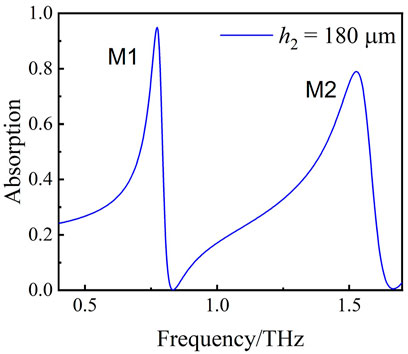- 1Key Laboratory of Ultrafast Photoelectric Technology and Terahertz Science in Shaanxi, Xi’an University of Technology, Xi’an, China
- 2Engineering University of PAP, Xi’an, Shaanxi, China
- 3School of Physical Science and Technology, Yangzhou University, Yangzhou, Jiangsu, China
Owing to the unique electromagnetic response ability, electromagnetic metasurface have potential applications in medical, imaging, sensing, and other fields. In this paper, a graphene-based THz metasurface sensor with an air spacer layer is designed by combining the advantages of the air spacer structure and the dynamic tunability of graphene materials. The proposed metasurface sensor consists of six layers, which are silicon dioxide (SiO2) substrate, metal reflector, air layer, graphene metasurface etched with microstructure, ion-gel layer and silicon dioxide dielectric layer from bottom to top. A comprehensive study of the absorption properties and sensing performance are carried out which is simulated and analyzed with the help of CST Microwave Studio software. The calculation results show that the two obvious resonance absorption peaks located at 0.95 THz and 1.53 THz with absorption of 94.9% and 79%, respectively, and there is a good linear relationship between the absorption peak and dielectric parameters of analyte. The frequency shift sensitivity of the two resonance peaks M1 and M2 can reach 450 GHz/RIU and 717 GHz/RIU, respectively. By changing the thickness of the air layer, when the two resonance peaks M1 and M2 reach the maximum absorption at
Introduction
Terahertz (THz) wave, generally defined in the frequency range of 0.1–10 THz, lie between the microwave and infrared frequencies in the electromagnetic spectrum. THz waves have both analyte penetration and analyte fingerprint recognition characteristics, making it widely used for analyte detection. Moreover, THz waves are non ionizing. So, when THz waves are used to detect analyte, they will not cause changes in material properties and structural damage due to ionization and high-intensity radiation, and can achieve non-destructive testing of analyte [1]. Metamaterials are composite materials made by artificial design. The properties are not only related to the physical properties of the constituent materials, but also related to the effect of the unit structure on waves, and have a single electromagnetic response characteristic that is not found in nature. This material consists of periodically arranged subwavelength units [2, 3], which can realize the local enhancement of electromagnetic fields [4–7]. It is also quite sensitive to the change of the dielectric environment around the structure [8, 9]. THz metamaterial sensor is an important functional device in the THz frequency band [10–13]. It realizes the detection of analyte by changing the resonance characteristics of the sensor due to the difference of the electromagnetic parameters of the measured analyte in the THz frequency band [14–17]. In 2017, Geng et al. reported A microfluidic-integrated terahertz metamaterial biosensor produces 19 GHz resonance shift (5 mu/ml) and 14.2 GHz resonance shift (0.02524 μg/ml) when detecting Alpha fetoprotein (AFP) and Glutamine transferase isozymes II (GGT-II), which can be used for the detection of early-stage liver cancer biomarkers [18]. At present, THz metamaterial sensors are mainly divided into transmissive metamaterial sensors and reflective metamaterial sensors [19], the designed and processed metamaterial sensor have a wide applicable occasion in biomolecule recognition, food quality control, environmental detection, and many other fields [20–22].
During the process of designing metamaterial absorbers, spacers can be incorporated in such a design (in terms of thickness and dielectric function) that it is critical to realize various applications [23, 24]. For example, partially etched partitions can be replaced with liquid crystals to achieve electrically tunable metamaterial absorbers [25–28]. Alternatively, VO2 can be used as the material of the air spacer. Can control the change of the material from the insulating layer to the air layer by changing the temperature. Meanwhile, the absorption resonance will be turned on and off due to the change of the material [29–32]. In addition, nonlinear characteristics can be introduced by integrating semiconductor materials in spacers [33–36]. Importantly, metamaterial absorbers typically have a higher quality factor than single-layer metamaterial, making them more suitable for sensing applications. However, the physical presence of dielectric spacers impedes access to volumes between the metamaterial layer and the ground plane, where the electric field is highly concentrated. In addition, dielectric loss of spacer materials will reduce the quality factor [37].
Graphene is a two-dimensional material made of carbon atoms arranged in a regular hexagonal shape similar to benzene rings. The surface conductivity of graphene can be artificially modulated by applying bias voltage or chemical doping to change the carrier concentration of graphene. Therefore, graphene can be dynamically modulated. Therefore, graphene may be a good candidate for the design and engineering of some tunable devices to the above modulation properties. It has been widely used in sensors, and the position of the resonance wavelength on the spectrum can be affected by the Fermi level, which can easily realize a wide range of graphene sensing [38–40].
In this paper, we combine an air-spaced structure with a highly concentrated electric field and a tunable graphene material to propose a graphene-based THz metasurface sensor with air-spaced structure which is simulated and analyzed with the help of CST Microwave Studio software, two resonance peaks located at 0.95 THz and 1.53 THz are observed. At the same time, the resonance mechanism is analyzed from impedance matching and electric field mode. In addition, the sensing characteristics of the sensor were also studied, and the sensitivity of the two resonance peaks M1 and M2 of the graphene absorption sensor can reach 450 GHz/RIU and 717 GHz/RIU, respectively. Furthermore, when the two peaks reach the maximum absorption, the sensitivity is still as high as close to 450 GHz/RIU.
Structure and design
The proposed graphene-based THz metasurface sensor consists of six layers, which are silicon dioxide (SiO2) substrate, metal reflector, air layer, graphene metasurface etched with the microstructure, ion-gel layer and silicon dioxide dielectric layer from bottom to top. The side view of the unit cell is shown in Figure 1A. The repeat period is
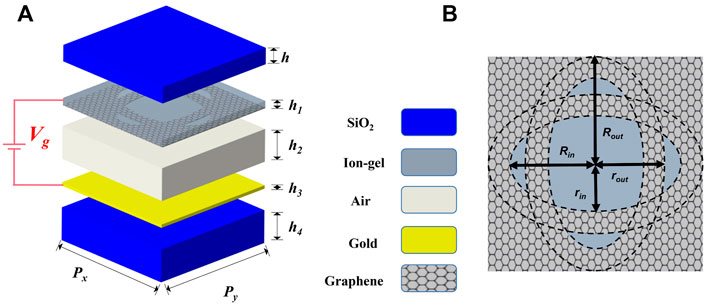
FIGURE 1. (A) Layered structure diagram of the graphene-based THz metasurface sensor. (B) Schematic diagram of the graphene microstructure, respectively.
In this paper, the conductivity model of graphene is mainly explained by the Kubo formula. Eqs 2, 3 represent the intraband conductivity and interband conductivity of graphene, respectively, where e is the electron charge, T is the temperature of the environment,
The intraband transition plays a leading role in the low frequency THz band rather than the interband transition. Here, the conductivity of graphene can be explained by the Drude model. For
The relative dielectric constant is [46].
where,
Results and discussion
The absorption of the air-spaced graphene metasurface sensor are studied by the frequency domain solver based on the finite element algorithm in the CST Microwave Studio software. In order to improve the accuracy and simulation speed of structure discretization, adaptive grid is used to divide the sensor structure. Owing to the symmetric structure, the TE direction is the same as the TM direction. When the THz wave is incident vertically (
Equivalent model analysis
According to transmission line theory, the graphene-based metasurface is equivalent to an RLC series circuit, which is shown in the Figure 3A. The equivalent impedance is Zg, Zg = Rg + j
Since the transmission coefficient of the sensor S21 = 0, the complex impedance Z of the sensor can be calculated by the reflection coefficient S11, and the calculation formula of the complex impedance Z is Eq. 6 [48]:
Figure 3B shows the absorption spectrum of graphene-based THz metasurface sensors when
Electric field distribution analysis
We set the inner radius of the elliptical ring to be
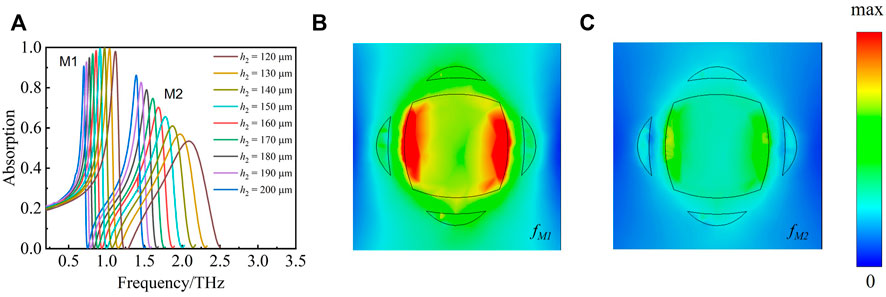
FIGURE 4. (A) The graph of the absorption lines corresponding to
Tunable performance analysis of graphene
Dynamic adjustment of the resonant frequency is a unique advantage of graphene-based THz metasurface sensors. The graphene-based THz metasurface sensors proposed in this study contains an ion-gel layer, and the positive and negative electrode of the bias voltage are connected to the ion-gel layer, and the metal reflective layer, respectively.
The Fermi level of graphene
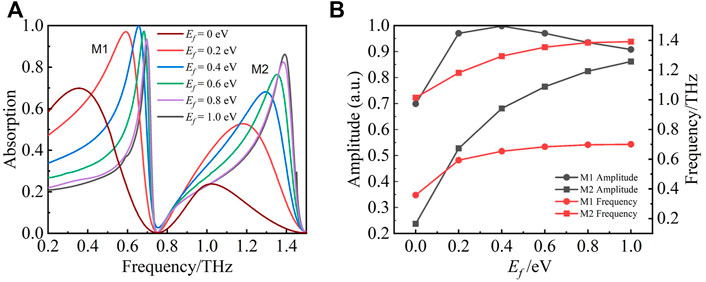
FIGURE 5. (A) The absorption spectra corresponding to the Fermi level (Ef) from 0 to 1.0 eV. (B) Line graph of maximum absorption and resonant frequency of absorption corresponding to the Fermi level (Ef) from 0 to 1.0 eV.
In addition, in the Figure 5A, it can be seen that the width of the working frequency band becomes narrower with the increase of Ef. The working bandwidth mainly depends on how fast Z0 Re(
The influence of graphene geometric parameters on the absorption
The influence of graphene geometric parameters on the absorption were also investigated. We set
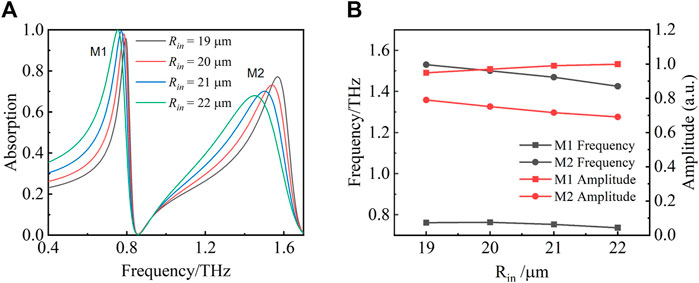
FIGURE 6. (A) The graph of the absorption lines corresponding to Rin from 19 to 22
Insensitive analysis of angle and polarization
The sensitivity of the proposed graphene-based THz metasurface sensor to the THz polarization angle were studied. Figure 7 shows that under the normal incidence of TE polarized THz wave, when the THz wave polarization angle
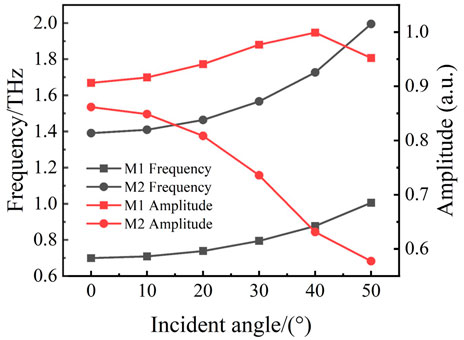
FIGURE 7. A Line graph of maximum absorption and resonant frequency of the absorption corresponding to incident angle from 0° to 50°.
Sensing performance of the proposed graphene-based THz metasurface sensor
Owing to the resonances,graphene-based THz metasurfaces are more sensitive to changes in the dielectric environment [50]. Therefore, the proposed graphene-based THz metasurface sensor can be used for sensing. During the sensor detection process, the analyte is placed in the air layer between the graphene layer and the metal layer, due to the change of the dielectric environment of the sensor surface, the sensor absorption spectrum will change. The thickness of the air layer affects the dielectric constant of the surrounding environment of the sensor, which will affect the sensing characteristics of the sensor. The strength of the sensor resonance absorption depends on the degree of matching between the equivalent impedance of the sensor and the impedance of free space. By adjusting the thickness of the air layer, the equivalent impedance of the sensor can be changed to make it well matched with the impedance of free space, thereby enhancing the absorption of THz wave. For this reason, this section studies the effect of air layer height on sensor characteristics with other parameters unchanged. In order to analyze the thickness of the air layer, the graphene Fermi level
where
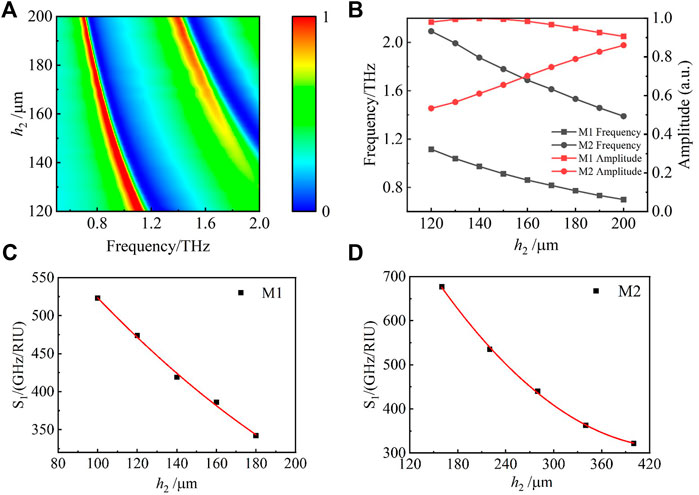
FIGURE 8. (A) Color graph of graphene-based THz metasurface sensor as the change of air layer. (B) Line graph of maximum absorption and resonant frequency of the absorption lines corresponding to h2 from 0° to 50°. (C) (D) Line graph of frequency shift sensitivity of resonance peak M1 and M2 corresponding to Re from 1 to 2.
The sensing performance are analyzed when
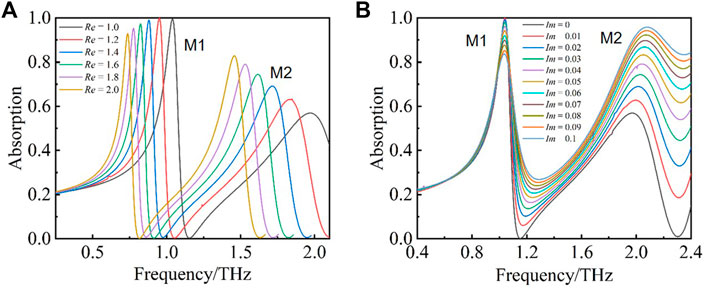
FIGURE 9. (A) Absorption lines of the graphene-based THz metasurface sensor when
According to Figures 10A,B, we can see that M1 and M2 reach the maximum absorption when
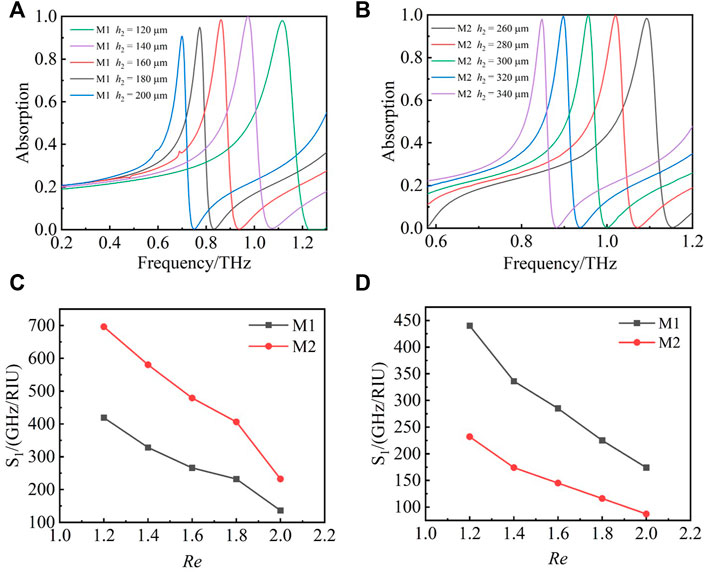
FIGURE 10. (A) Absorption line of the resonance peak M1 as h2 varies from 120 to 200
Conclusion
In summary, a graphene-based THz metasurface sensor with an air spacer is proposed. The absorption spectrum of this sensor was studied. The resonance mechanism was analyzed by impedance matching and electric field distribution. There is a good linear relationship between the absorption peak and the dielectric environment of the sensor surface at 0∼2 THz, and the frequency shift sensitivity of the two resonance peaks M1 and M2 can reach 450 GHz/RIU and 717 GHz/RIU, respectively. By changing the thickness of the air layer, when the two resonance peaks reach the maximum absorption, the frequency shift sensitivity is still as high as close to 450 GHz/RIU. The influence of structural parameters and incident angle on the absorption spectra is studied, it is found that the structural parameters and incident angle have little effect on the device within a certain range, and analyte detection can still be achieved. The above results show that the sensor has good stability and reliability. The graphene-based THz metasurface sensor can be used for analyte sensing, which broadens the application range of THz functional devices.
Data availability statement
The original contributions presented in the study are included in the article/supplementary material, further inquiries can be directed to the corresponding authors.
Author contributions
HH and BQ conceived and led the design; BQ and XZ finished the whole manuscript writing and the manuscript modification, YW, XH, and YZ contributed to the proofreading, revised the article format, and all authors listed approved it for publication.
Funding
This work was supported in part by the Natural Science Foundation of Shaanxi Province under Grant 2020JZ-48; Youth Innovation Team of Shaanxi Universities(21JP084), and by the National Natural Science Foundation of China (61975163).
Conflict of interest
The authors declare that the research was conducted in the absence of any commercial or financial relationships that could be construed as a potential conflict of interest.
Publisher’s note
All claims expressed in this article are solely those of the authors and do not necessarily represent those of their affiliated organizations, or those of the publisher, the editors and the reviewers. Any product that may be evaluated in this article, or claim that may be made by its manufacturer, is not guaranteed or endorsed by the publisher.
References
1. Zhang X, Xu Q, Xia L, Li Y, Gu J, Tian Z, et al. Terahertz surface plasmonic waves: a review. Adv Photon (2020) 2:014001. doi:10.1117/1.AP.2.1.014001
2. Jiang T, Chen RZ, Zheng X, Xu ZJ, Tang YH. Photo-induced excitonic structure renormalization and broadband absorption in monolayer tungsten disulphide. Opt Express (2018) 26:859. doi:10.1364/oe.26.000859
3. Wu XJ, Quan BG, Pan XC, Xu XL, Lu XC, Gu CZ, et al. Alkanethiol-functionalized terahertz metamaterial as label-free, highly-sensitive and specificbiosensor. Biosens Bioelectron X (2013) 42:626–31. doi:10.1016/j.bios.2012.10.095
4. Wang AX, Wang JF, Zhang JQ, Wang WJ, Xu CL. Ultra wide-angle and broad-band metamaterial absorber based on magneto-electric dipole structure. J Phys D Appl Phys (2021) 54:335102. doi:10.1088/1361-6463/ac0071
5. Hu YZ, Tong MY, Xu ZL, Cheng XG, Jiang T. Metamaterials: Bifunctional spatiotemporal metasurfaces for incident angle‐tunable and ultrafast optically switchable electromagnetically induced transparency (small 21/2021). Small (2021) 17:2170097. doi:10.1002/smll.202170097
6. Han JG, Tian Z, Gu JQ, He MX, Zhang WL. Composite metamaterials with tunable chiral properties at terahertz frequencies. Chin Opt Lett (2011) 9:s10401–310403. doi:10.3788/COL201109.S10401
7. Zhou T, Chen S, Zhang X, Zhang X, Hu H, Wang Y. Electromagnetically induced transparency based on a carbon nanotube film terahertz metasurface. Opt Express (2022) 30:15436–45. doi:10.1364/OE.457768
8. Wang JF, Qu SB, Zhuo X, Song X, Qiu ZJ, Hua M, et al. Experimental verification of left-handed metamaterials composed of electric and magnetic resonators. Acta Phys Sin (2010) 27:1847. doi:10.7498/aps.59.1847
9. Yang J, Qi L, Li B, Wu L, Shi D, Ahmed U, et al. A terahertz metamaterial sensor used for distinguishing glucose concentration. Results Phys (2021) 26:104332. doi:10.1016/j.rinp.2021.104332
10. Wang JF, Qu SB, Xu Z, Zhang JQ, Yang YM, Ma H, et al. A candidate three-dimensional GHz left-handed metamaterial composed of coplanar magnetic and electric resonators. Photon Nanostructures - Fundamentals Appl (2008) 6:183–7. doi:10.1016/j.photonics.2008.08.001
11. Karmakar S, Kumar D, Varshney RK, Chowdhury DR. Strong terahertz matter interaction induced ultrasensitive sensing in Fano cavity based stacked metamaterials. J Phys D Appl Phys (2020) 53:415101. doi:10.1088/1361-6463/ab94e3
12. Chen T, Zhang D, Huang F, Li Z, Hu F. Design of a terahertz metamaterial sensor based on split ring resonator nested square ring resonator. Mater Res Express (2020) 7:095802. doi:10.1088/2053-1591/abb496
13. Zhu WR, Zhao XP, Gong BY. Left-handed metamaterials based on a leaf-shaped configuration. J Appl Phys (2011) 109:093504. doi:10.1063/1.3583544
14. Sun R, Li W, Meng T, Zhao G. Design and optimization of terahertz metamaterial sensor with high sensing performance. Opt Commun (2021) 494:127051. doi:10.1016/j.optcom.2021.127051
15. Tan S, Yan F, Wang W, Zhou H, Hou Y. Ultrasensitive sensing with three-dimensional terahertz metamaterial absorber. J Opt (2018) 20:055101. doi:10.1088/2040-8986/aab66e
16. Zhang HY, Cao YY, Liu YZ, Li Y, Zhang YP. A novel graphene metamaterial design for tunable terahertz plasmon induced transparency by two bright mode coupling. Opt Commun (2017) 391:9–15. doi:10.1016/j.optcom.2017.01.008
17. Wang BX, He Y, Lou P, Xing W. Design of a dual-band terahertz metamaterial absorber using two identical square patches for sensing application. Nanoscale Adv (2020) 2:763–9. doi:10.1039/c9na00770a
18. Geng Z, Zhang X, Fan Z, Lv X, Chen H. A route to terahertz metamaterial biosensor integrated with microfluidics for liver cancer biomarker testing in early stage. Sci Rep (2017) 7:16378–11. doi:10.1038/s41598-017-16762-y
19. Yao H, Mei H, Zhang W, Zhong S, Wang X. Theoretical and experimental research on terahertz metamaterial sensor with flexible substrate. IEEE Photon J (2022) 14:1–9. doi:10.1109/jphot.2021.3124414
20. Geng Z, Zhang X, Fan Z, Lv X, Chen H. A route to terahertz metamaterial biosensor integrated with microfluidics for liver cancer biomarker testing in early stage. Sci Rep (2017) 7:16378. doi:10.1038/s41598-017-16762-y
21. Xu XL, Song L, Shi YL, Yang YP, Xie SS, Li W. Light-induced dielectric transparency in single-walled carbon nanotube films. Chem Phys Lett (2005) 410:298–301. doi:10.1016/j.cplett.2005.05.078
22. Xu W, Xie L, Zhu J, Tang L, Singh R, Wang C, et al. Terahertz biosensing with a graphene-metamaterial heterostructure platform. Carbon (2019) 141:247–52. doi:10.1016/j.carbon.2018.09.050
23. Chen CX, Can S, Schalch J, Zhao XG, Duan GW, Averitt RD, et al. Ultrathin terahertz triple-band metamaterial absorbers: Consideration of interlayer coupling. Phys Rev Appl (2020) 14:054021. doi:10.1103/physrevapplied.14.054021
24. Schalch J, Duan G, Zhao X, Zhang X, Averitt R. Terahertz metamaterial perfect absorber with continuously tunable air spacer layer. Appl Phys Lett (2018) 113:061113. doi:10.1063/1.5041282
25. Shrekenhamer D, Chen WC, Padilla WJ. Liquid crystal tunable metamaterial absorber. Phys Rev Lett (2013) 110:177403. doi:10.1103/PhysRevLett.110.177403
26. Wang L, Ge S, Hu W, Nakajima M, Lu Y. Graphene-assisted high-efficiency liquid crystal tunable terahertz metamaterial absorber. Opt Express (2017) 25:23873–9. doi:10.1364/OE.25.023873
27. Wang RX, Li L, Liu JL, Yan F, Tian FJ, Tian H, et al. Triple-band tunable perfect terahertz metamaterial absorber with liquid crystal. Opt Express (2017) 25:32280–9. doi:10.1364/oe.25.032280
28. Yin Z, Lu Y, Xia T, Lai W, Yang J, Lu H, et al. Electrically tunable terahertz dual-band metamaterial absorber based on a liquid crystal. RSC Adv (2018) 8:4197–203. doi:10.1039/c7ra13047c
29. Dicken MJ, Aydin K, Pryce IM, Sweatlock LA, Atwater HA, Walavalkar S, et al. Frequency tunable near-infrared metamaterials based on VO2 phase transition. Opt Express (2009) 17:18330–9. doi:10.1364/OE.17.018330
30. Lu C, Lu Q, Gao M, Lin Y. Dynamic manipulation of THz waves enabled by phase-transition VO2 thin film. Nanomaterials (2021) 11:114. doi:10.3390/nano11010114
31. Zhao Y, Chen C, Pan X, Zhu Y, Holtz M, Bernussi A, et al. Tuning the properties of VO2 thin films through growth temperature for infrared and terahertz modulation applications. J Appl Phys (2013) 114:113509. doi:10.1063/1.4821846
32. Zhu HF, Du LH, Li J, Shi QW, Peng B, Li ZR, et al. Near-perfect terahertz wave amplitude modulation enabled by impedance matching in VO2 thin films. Appl Phys Lett (2018) 112:081103. doi:10.1063/1.5020930
33. Aslinezhad M. High sensitivity refractive index and temperature sensor based on semiconductor metamaterial perfect absorber in the terahertz band. Opt Commun (2020) 463:125411. doi:10.1016/j.optcom.2020.125411
34. Keshavarz A, Zakery A. Ultrahigh sensitive temperature sensor based on graphene-semiconductor metamaterial. Appl Phys A (2017) 123:797–7. doi:10.1007/s00339-017-1399-y
35. Tang T, Li C, Luo L, Zhang Y, Li J. Goos–Hänchen effect in semiconductor metamaterial waveguide and its application as a biosensor. Appl Phys B (2016) 122:167–7. doi:10.1007/s00340-016-6447-3
36. Zhao XG, Zhang JD, Fan KB, Duan GW, Metcalfe GD, Wraback M, et al. Nonlinear terahertz metamaterial perfect absorbers using GaAs [Invited]. Photon Res (2016) 4:A16–A21. doi:10.1364/prj.4.000a16
37. Duan G, Jacob S, Zhao X, Zhang J, Averitt RD, Xin Z. An air-spaced terahertz metamaterial perfect absorber. Sensors Actuators A: Phys (2018) 280:303–8. doi:10.1016/j.sna.2018.07.052
38. Xiao BG, Tong SJ, Alexander F, Shi ZM. Tunable electromagnetically induced transparency based on graphene metamaterials. Opt Express (2020) 28:4048–57. doi:10.1364/OE.382485
39. Xiao B, Wang Y, Cai W, Xiao L. Design and prediction of PIT devices through deep learning. Opt Express (2022) 30:14985–97. doi:10.1364/OE.449465
40. Cai WJ, Xiao BG, Yu JB, Xiao LH. A compact graphene metamaterial based on electromagnetically induced transparency effect. Opt Commun (2020) 475:126266. doi:10.1016/j.optcom.2020.126266
41. Barzegar-Parizi S, Ebrahimi A. Ultrathin, polarization-insensitive multi-band absorbers based on graphene metasurface with THz sensing application. J Opt Soc Am B (2020) 37:2372. doi:10.1364/josab.396266
42. Biabanifard M, Arsanjani A, Abrishamian MS, Abbott D. Tunable terahertz graphene-based absorber design method based on a circuit model approach. IEEE Access (2020) 8:70343–54. doi:10.1109/access.2020.2986682
43. Zhang D, Li Z, Fan K, Chen T, Jia B, Pan S, et al. Dynamically tunable terahertz metamaterial sensor based on metal–graphene hybrid structural unit. AIP Adv (2022) 12:025206. doi:10.1063/5.0079964
44. Koppens FHL, Chang DE, JavierGarcía F. Graphene plasmonics: A platform for strong light–matter interactions. Nano Lett (2011) 11:3370–7. doi:10.1021/nl201771h
45. Lui CH, Li Z, Mak KF, Cappelluti E, Heinz TF. Observation of an electrically tunable band gap in trilayer graphene. Nat Phys (2011) 7:944–7. doi:10.1038/nphys2102
46. Andryieuski A, Lavrinenko AV. Graphene metamaterials based tunable terahertz absorber: Effective surface conductivity approach. Opt Express (2013) 21:9144–55. doi:10.1364/OE.21.009144
47. Wen Q, Xie Y, Zhang H, Yang Q, Liu Y. Transmission line model and fields analysis of metamaterial absorber in the terahertz band. Opt Express (2009) 17:20256–65. doi:10.1364/OE.17.020256
48. Smith DR, Vier DC, Koschny T, Soukoulis CM. Electromagnetic parameter retrieval from inhomogeneous metamaterials. Phys Rev E (2005) 71:036617. doi:10.1103/PhysRevE.71.036617
49. Qi Y, Zhang Y, Liu C, Zhang T, Wang X, Wang L, et al. A tunable terahertz metamaterial absorber composed of elliptical ring graphene arrays with refractive index sensing application. Results Phys (2020) 16:103012. doi:10.1016/j.rinp.2020.103012
50. Zhang K, Yuan YY, Ding XM, Ratni B, Burokur SN, Wu Q. High-efficiency metalenses with switchable functionalities in microwave region. ACS Appl Mater Inter (2019) 11:28423–30. doi:10.1021/acsami.9b07102
51. Liu BW, Chen S, Zhang JC, Yao X, Zhong JH, Lin HX, et al. A plasmonic sensor array with ultrahigh figures of merit and resonance linewidths down to 3 nm. Adv Mater (2018) 30:1706031. doi:10.1002/adma.201706031
Keywords: graphene, THz, metasurface, air spacer, sensing
Citation: Hu H, Qi B, Zhao Y, Zhang X, Wang Y and Huang X (2022) A graphene-based THz metasurface sensor with air-spaced structure. Front. Phys. 10:990126. doi: 10.3389/fphy.2022.990126
Received: 09 July 2022; Accepted: 22 August 2022;
Published: 14 September 2022.
Edited by:
Xinzhong LI, Henan University of Science and Technology, ChinaReviewed by:
Dibakar Roy Chowdhury, Mahindra École Centrale College of Engineering, IndiaBinggang Xiao, China Jiliang University, China
Copyright © 2022 Hu, Qi, Zhao, Zhang, Wang and Huang. This is an open-access article distributed under the terms of the Creative Commons Attribution License (CC BY). The use, distribution or reproduction in other forums is permitted, provided the original author(s) and the copyright owner(s) are credited and that the original publication in this journal is cited, in accordance with accepted academic practice. No use, distribution or reproduction is permitted which does not comply with these terms.
*Correspondence: Bin Qi, Mjc4MzA3ODkwMkBxcS5jb20=; Xinning Huang, aHVhbmd4aW5uaW5nQHl6dS5lZHUuY24=
 Hui Hu
Hui Hu Bin Qi
Bin Qi Yufan Zhao1
Yufan Zhao1 Xiaoju Zhang
Xiaoju Zhang Yue Wang
Yue Wang Xinning Huang
Xinning Huang